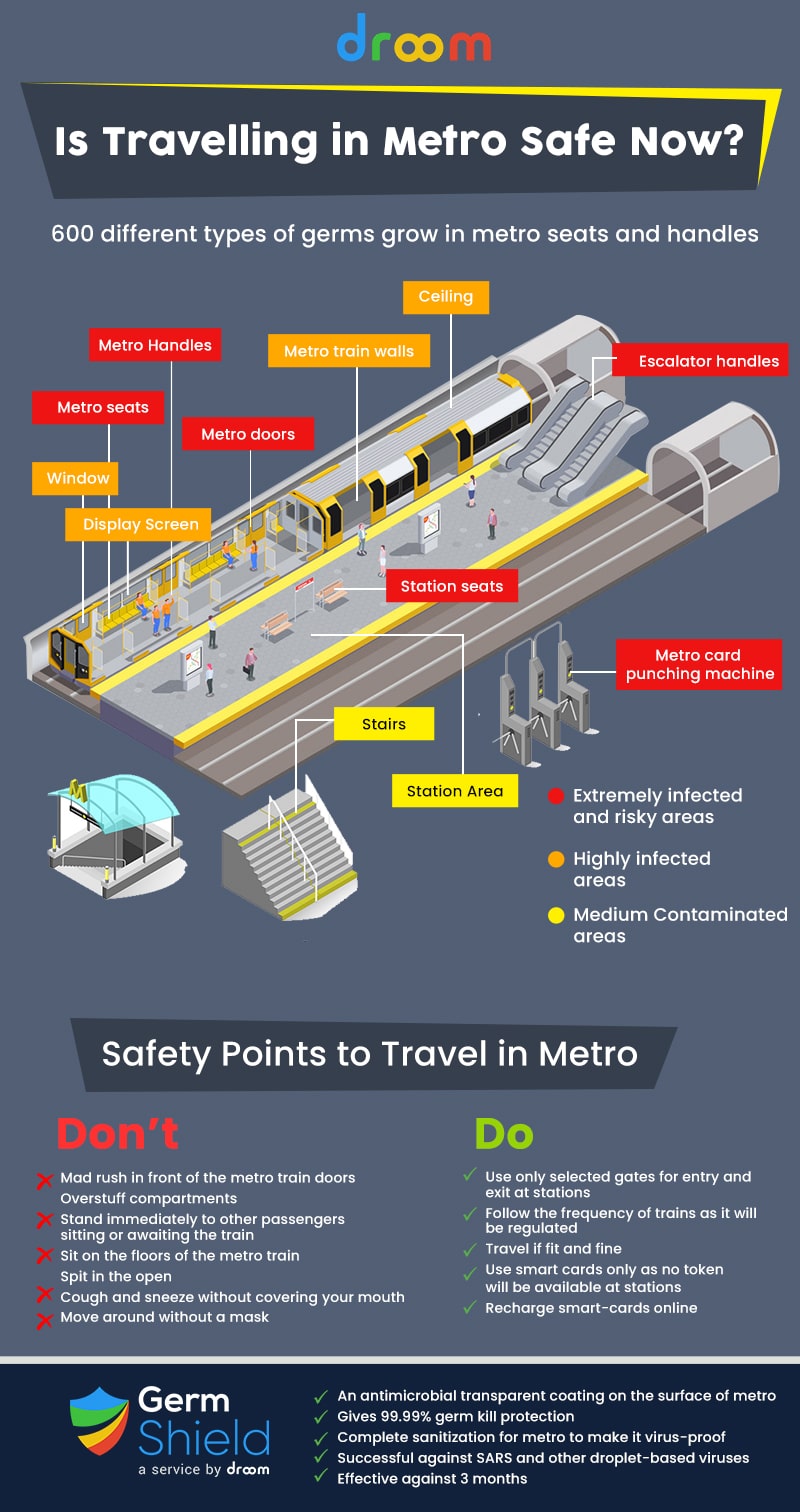The Indian metro railways are one of the prime options of public transport within the domain of ‘Big Transport’. Just like all the other aspects of modern civilization, the Indian Metro Railway operations also experienced a halt due to the spread of the deadly virus. As the virus attain the form of a pandemic like the other means of public conveyance, the metro railways in the various cities of India ceased to function. This dealt a huge blow to the daily life, commuting conveyance of the office goers and also the national economy as a whole. However, the situation is changing, metro is reopening in India.  under the guidelines of Unlock 4 in an attempt to return to normal life with the ‘new normal norms’ the Home Ministry has declared that the from 7th September in a graded manner.
under the guidelines of Unlock 4 in an attempt to return to normal life with the ‘new normal norms’ the Home Ministry has declared that the from 7th September in a graded manner.
Latest Update on Metro Service in Delhi
7 September to 8 September – Metro timings- 7 am to 11 am and 4 pm to 8 pm, Metro line opening – Only Yellow Line of Delhi Metro railways – from Samaypur Badli to Huda City Centre and Rapid Metro— will be functional in phase I.
9 September – Metro timings- 7 am to 11 am and 4 pm to 8 pm, Metro line opening – Blue Line & Pink Line
10 September – Metro timings- 7 am to 11 am and 4 pm to 8 pm, Metro line opening – Red Line (Ghaziabad to Rithala), the Bahadurgarh line, and the Faridabad line (after observing the operation and its impact)
11 September – Metro timings- 7 am to 1 pm and 4 pm to 10 pm
12 September – Delhi timings – 6 am to 11 pm To maintain social distancing:
- Only selected gates for entry at stations and a separate gate for exit
- Frequency of trains will also be regulated
- Only asymptomatic patients will be allowed
- No token available at the stations, only smart-cards are permitted
- Smart-cards need to recharged online
Since when is the metro closed?
In India, the operations of the Metro Railways were stalled from 22nd March 2020. The process began with the onset of the ‘Janata Curfew’. This was a step taken to contain the spread of virus. Research proved that places, where crowds accumulated in large bulk, could become the major points of spread. Metro railways being one of the most popular forms of public conveyance had a monumental volume of human traffic daily. Authorities rightly summed up that stalling the operations of the metro railways could help control the spread of the pandemic. Initially, it was declared that the metros will suspend till 31st March 2020. However, its operations have not been reopened to date. Metro reopening in India is a very vital decision that must be implemented with stringent rules and regulations to make this public conveyance a safe and friendly transport mode.
From when will the metro restart?
The Indian Home Ministry has released the statement that the metro is reopening in India. It has been stated that from 7th September 2020 based on the new guidelines issued by the Center the metro corporations of different cities will be resumed their services with certain restrictions. A new standard operating procedure (SOP) has been issued on 1st September will be used to resume the metro rail services. Cities like Delhi, Chennai, Noida, Bangalore, Kochi, Jaipur, Hyderabad, Nagpur, Gurugram, Kolkata, and Lucknow will be resuming their metro rail services. However, the government of Maharashtra has decided to keep its metro rail operations suspended for the time being. The Union Housing Minister Hardeep Puri has declared that the Mumbai Line-1 along with the operations of the other Maharashtra, metro pockets will begin only from October 2020. The date may get postponed if the state government so decides.
What are the new guidelines?
Now the question ‘whether the metro is open or not?’ is answered, it is time that we run a quick look through the new guidelines that will be followed by the Metro Rail authorities. The authorities have declared that although the metro rail operations will begin, the operations will be staggered at the beginning. The authorities intend to make a slow start and gradual progress so that the entire operation can be resumed by 12th September. The guidelines reveal that the stations which will fall under the containment zones will be kept closed. Initially, the hours of operations will be reduced. However normal hours will be resumed by 12th September 2020. A strict vigilance will be kept on the conduct of the passengers in the stations. Metro trains will not stop in the stations where the passengers will fail to abide by the rules of social distancing or will act in an unruly manner. There will be markings inside the stations and the trains so that the passengers can maintain social distancing. Wearing a mask is mandatory. Those who will not have a mask will have to buy one at the station.
Which metro station is closed today in Delhi?
As per the new guidelines the metro rail services are to begin in Delhi on 7th September 2020. The list of the metro stations that will be opened and the ones that will remain closed are yet to be disclosed by the central government. However, several new measures will be implemented to ensure greater security of the passengers. To begin with, the trains will now wait at the station for a longer period so that the passengers can board and leave the train in a more systematic manner observing all the rules of social distancing. Only a single entrance and exit point will be kept open in the metro stations to monitor the crowd better. Strict CCTV vigilance will be implemented. Smart cards will be activated in the place of the earlier tokens.
What is the average bulk of passenger traffic in metros?
The metro rails are a major option of public conveyance. Amongst the different cities of the nation, the metro networks of Kolkata and Delhi are the most significant ones – the former is the oldest metro network and the latter is the busiest one. In a busy day, the Delhi metro carry almost 2.8 million passengers and Kolkata metro carries almost 7 lakhs passengers every day.
In almost all the cities the metros begin by the early morning hours (between 6 am and 7 am) and the services continue till late at night (till 10 pm and 11 pm). The network connects some of the most remote corners of the city with each other connecting a fine network of conveyance throughout the city. The bulk traveling through these metro rails is quite a voluminous one. The fact that during the 170 days of suspending the metro operations, 1300 crores INR has been lost – sums up the average bulk that uses the metros.
What percentage is expected to get revived in the current times of pandemic?
Experts think that the initial phase soon after the Delhi metro start date will see a humungous spike in the number of metro passengers. In this perspective, some speculate that a certain percentage of the earlier traffic traveling by metro might still steer clear due to the pandemic threat. However, the regular office going staff will opt for this mode of transport with increased caution. The closure of the schools, colleges, and universities could be one of the reasons reducing the passenger traffic of the metros.
Is the metro safe?
Now that the date of metro service resumption has been released, a general question is haunting the psyche of the common man – ‘is traveling by metro a safe option?’ In this context, it must be given in the benefit of the common man that in the current status of the pandemic and all the theories of how it is spreading amongst the healthy population, any place that has a lot of crowds must be avoided. This is why all public transport mediums are sources of potential threat. The metro railways are no exception.
What is the threat potentiality of the metros?
Metros are fast and economic public transport modes which attract a large percentage of the urban population. Often in the peak hours, the trains coming up and down the lines are overcrowded, to say the least. The rush is quite maddening and not just in terms of the trains that are running on the metro tracks. The volume of passengers waiting on the stations, using the escalators, standing in a queue for tickets/tokens, waiting to get frisked is quite overwhelming, especially during the peak hours. Quintessentially we understand that the threat of community spread of virus from these metros is potentially high. With this opinion, the authorities have designed new metro guidelines after lockdown as a structured attempt to reopen the metros and resume its services in a cautious, calculated, and calibrated manner.
How to make the metro safe to travel?
So far, two things have emerged clearly from this discussion – metro railway services are integrally important for smooth and convenient public transport, besides being a major economic boost and secondly it is a potential threat of accentuated community spread of the reigning pandemic. Hence, two ends must be met – where on one hand the metro services must be revived, on the other hand proper sanitization and disinfection of the metro railways must be brought to effect.
Metro railways have several surface tops like the ticket/token countertops, the tickets/tokens, the frisking stations, the token insertion bays, the escalator railings, the seats, and their hand rests on the stations, the railings and the holding supports within the trains, the seats, and their hand rests within the trains, etc. All these surface tops could get contaminated by infected passengers increasing the risk of contagion for the healthy passengers. This is why proper metro sanitizing services have become mandatory in the current times. These services along with a properly maintained protocol of social distancing can effectively curb the threat of community spread of Corona Virus in India.
How to avoid the spread of the virus and what passenger habits and behaviors must be controlled?
Irrespective of the city where the metro railways are operating like Delhi, Kolkata, or Bangalore there are certain cliché irresponsible behavior and habits of the metro passengers which accentuates the danger of community spread of this dreaded pandemic. To control the threat the citizens of the nation must bring a certain change in their fundamental nature. One of the very first and elementary things that must be borne in mind by the passengers is to maintain proper social distance between them and the other passengers. This protocol must be strictly followed right from entering the metro stations until leaving it. Proper markings will be provided on the station platforms and within the train, compartments adhering by which the passengers can maintain a proper distance between them and the other passengers at all points of time. Very importantly as an undisputed point of the ‘new normal times’ passengers must have enough time on their hands, so that, they do not need to rush.
- Mad rushes in front of the metro train doors
- Overstuffed compartments
- Standing immediately to other passengers sitting or awaiting the train
- Sitting on the floors of the metro train
- Spitting in the open
- Coughing and sneezing without covering your mouth
- Talking loudly
- Moving about without a mask
These unhygienic practices must be avoided at all costs and must be made punishable offenses. Hygienic practices like sanitizing hands, wearing masks, body temperature monitoring, etc., must be practiced with increased strictness.
What is the best way to safeguard the metro and you?
The best way to sanitize metro is with Germ Shield, the supreme quality antimicrobial coating. Places that needs special attention are handles, doors, seats, escalator handles, metro card punching machine, etc. These must be sanitized completely and must restrict the contagion from one person to another. Metro authority should do the threat perception.
This zone division has been done based on touch-points potentiality:
![]() Metro handles, metro doors, metro seats, escalator handles, metro card punching machine, station seats, elevators – Red zone (Extremely infected and risky areas)
Metro handles, metro doors, metro seats, escalator handles, metro card punching machine, station seats, elevators – Red zone (Extremely infected and risky areas)
![]() Metro train walls, ceiling, windows, display screen – Orange zone (Highly infected areas)
Metro train walls, ceiling, windows, display screen – Orange zone (Highly infected areas)
![]() Stairs, station area – Yellow zone (Medium Contaminated areas)
Stairs, station area – Yellow zone (Medium Contaminated areas)
You as a responsible citizen must ask this. It is our responsibility to keep ourselves and our society safe. Instead of worrying and refraining us from public transport, it is better to ask have they opted for metro sanitization services that not only kill the existing viruses, but also will secure metro by inhibiting the growth of those deadly viruses for next 3 months.
Like any other passenger vehicle, metro racks can be become affluent source of contagious diseases. Over 600 different types of germs can grow in the metro especially in the seats and handles, if not cleaned and sanitized properly. To safeguard the metro, it is not enough to just simply disinfect and sanitize the surface tops. The metro railways are exposed to a huge volume of human traffic. Hence the surface tops of the place are exposed to some of the deadliest microbes known to us.
To sanitize and disinfect the metro railways specialized sanitization services like Germ Shield are required.
- US patented technology of antimicrobial coating
- Highly scientific disinfecting treatment
- ISO certified
- Eradicates 99.9% of microbes including the droplet-based SARS and MARS viruses
- Kills and removes all types of microbes
- Applied through electrostatic sprayers by specially trained experts
- Digital swab testing is carried out before and after the treatment to determine the contamination level of the surface tops
- Forms an invisible layer on the surface tops
- Protects the layer from further microbe attack
- Remains effective for 3 months or 90 days
This is a sanitization process that can be implemented in no time. It takes about fifteen to thirty minutes to complete the entire process. The invisible layer comes without any color or odor and hence does not affect the ambiance in any way. It is perfectly safe for all of us including infants, children, elderly, pregnant women, and sick and recovering patients. Germ Shield is a technology that can be applied to any type of surface material like wood, metal, concrete, tiles, electronic devices, electrical appliances, glass, fabric, linen, plastic, rubber, etc.
Conclusion
On a concluding note, the metro railways are a rather important mode of public transport. The initial success of the metros in Kolkata and Delhi has led to a major herald and expansion of the projects in several other cities of the country. Apart from being one of the fastest and cheapest forms of transport, it is a huge support for the national economy. However, just like any other place that garners a substantial crowd, the metros also pose an increased risk to the already ascending index of the contagious pandemic.
Although resuming the metro services are important, it must be done cautiously, implementing several steps of precaution, so that, it does not become the principal reason for a fresh spike in the daily number of cases of virus infection. To bring about this measure the twin aspects of metro sanitization and maintenance of social distancing are more than imperative. Armed with these two guards, the services of the metros can be resumed helping the nation to move a step further towards the ‘new normal’.
Droom is an automobile e-commerce platform offering a 21st-century automotive buying experience online with its four value pillars including trust, selection, low price, and convenience second to none. It offers 250k+ vehicles online in 1,100 cities — both used and new. Droom deals in buying and selling cars, 2-wheelers, and other vehicles too. It is an AI and data science-driven platform designed with the best ecosystem tools. Here, we have a team of auto-experts and auto enthusiasts who are dedicated to covering every sphere of the auto industry by simplifying the procedure of buying and selling with Unified Droom Experience. To know more, click here.









